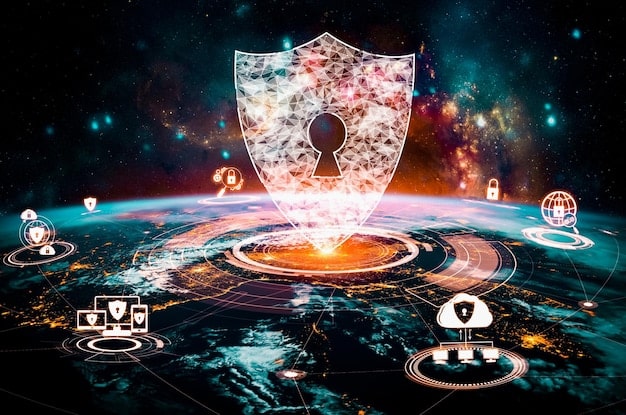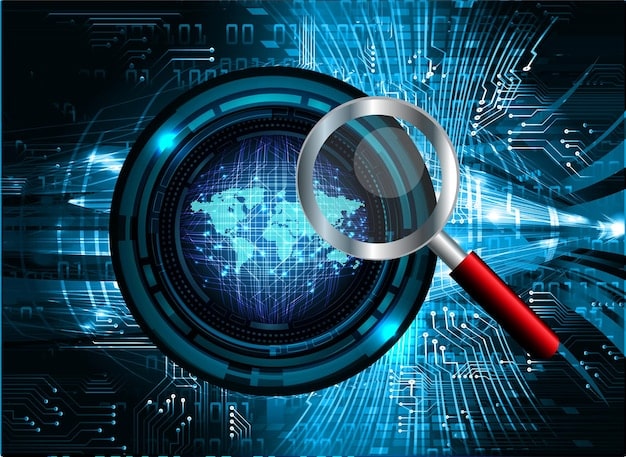How Technology Fights US Misinformation & Disinformation

Technology is actively deployed in the US to combat misinformation and disinformation through AI-driven content analysis, fact-checking platforms, digital literacy tools, and collaborative reporting networks, aiming to restore trust in information landscapes.
In an era defined by rapid digital connectivity, the proliferation of false narratives has become a pressing societal challenge. Understanding how technology is being used to combat misinformation and disinformation in the US is crucial, as innovation offers powerful tools to identify, debunk, and mitigate the spread of misleading content, fostering a more informed public sphere.
The Digital Battlefield: Understanding Misinformation and Disinformation
The distinction between misinformation and disinformation, while often blurred, is critical. Misinformation refers to false or inaccurate information spread mistakenly, without intent to deceive. Disinformation, on the other hand, is deliberately created and disseminated with the intent to mislead or manipulate, often for political, financial, or social gain. Both pose significant threats to democratic processes, public health, and social cohesion in the US. The digital landscape, with its speed and reach, acts as an unparalleled amplifier for both.
The motivation behind these narratives varies widely, from state-sponsored influence campaigns designed to sow discord to individuals spreading hoaxes for personal amusement or virality. Regardless of the source or intent, the impact can be profound. For instance, false health claims can lead to vaccine hesitancy, while politically charged narratives can influence elections or incite civil unrest. The challenge for technology is not merely to identify falsity, but to understand the nuances of context, intent, and impact.
Historically, the spread of false information was limited by geographical boundaries and the pace of traditional media. The internet, however, has dismantled these barriers, allowing content to travel globally in an instant. Social media platforms, in particular, due to their algorithmic structures that often prioritize engagement, inadvertently contribute to the problem by amplifying content that evokes strong emotional responses, regardless of its truthfulness. This has created an urgent need for technological solutions that can operate at scale and speed.
Moreover, the rise of sophisticated deceptive techniques, such as deepfakes and manipulated media, makes manual fact-checking increasingly insufficient. These advanced methods exploit human cognitive biases and make it difficult for an average user to discern truth from fabrication. This necessitates the development of cutting-edge technological countermeasures that can keep pace with the evolving tactics of malicious actors. The proactive detection and mitigation of these threats are paramount to maintaining a healthy information ecosystem.
Combating these phenomena requires a multi-faceted approach, integrating human expertise with technological prowess. It’s not just about filtering out “bad” content, but also about building resilience within information systems and empowering users with critical thinking skills. The core objective is to ensure that the public has access to reliable, verified information, enabling informed decision-making across all sectors of society. This ongoing battle is a testament to the complex interplay between technology, human behavior, and societal well-being.
AI and Machine Learning: Powering the Fight
Artificial Intelligence (AI) and Machine Learning (ML) are at the forefront of technological efforts to combat misinformation and disinformation. These technologies offer the ability to process vast amounts of data at speeds impossible for humans, identifying patterns and anomalies indicative of false content. From sophisticated natural language processing (NLP) to image and video analysis, AI provides crucial tools for detection and mitigation.
Natural Language Processing for Text Analysis
NLP models are trained on massive datasets to understand context, tone, and linguistic patterns. They can detect subtle linguistic cues often associated with deceptive text, such as hyper-partisan language, emotionally manipulative phrasing, or inconsistencies in narratives. This enables platforms to flag potentially problematic content before it reaches a wide audience.
- Sentiment Analysis: Identifying extreme emotional tones in text.
- Language Pattern Recognition: Detecting use of propaganda techniques or hate speech.
- Source Verification: Cross-referencing claims with reputable news sources.
- Contextual Understanding: Assessing the veracity of claims within a broader narrative.
Furthermore, NLP can be used to track the spread of specific narratives, identifying key influencers and propagation networks. This network analysis is vital for understanding how false information goes viral and for targeting intervention efforts effectively.
Deepfake Detection and Media Forensics
The emergence of deepfakes, highly realistic fabricated images, audio, and video, poses a severe threat. AI-powered media forensics tools are being developed to detect these manipulations by analyzing subtle inconsistencies that are imperceptible to the human eye or ear. These tools look for digital artifacts, facial distortions, or unnatural movements that indicate synthetic media.
For example, algorithms can analyze pixel-level anomalies in images or detect discrepancies in sound waves within audio files. This is a continuously evolving field, as creators of deepfakes constantly refine their techniques, necessitating a continuous arms race in detection technology. Universities and tech companies are heavily invested in developing more robust detection methods. This continuous development is essential to stay ahead of malicious actors who adapt their techniques rapidly.
Fact-Checking Platforms and Collaborative Networks
Beyond automated detection, technology significantly enhances human fact-checking efforts. Dedicated fact-checking organizations, often supported by technological tools, play a vital role in verifying claims and debunking false narratives. Collaborative networks further amplify these efforts, ensuring a broader reach and faster response times. These platforms operate across various media types, from text to video.
Dedicated Fact-Checking Websites and Databases
Organizations like PolitiFact, Snopes, and FactCheck.org use rigorous methodologies to investigate claims. Their websites serve as public databases of debunked myths and verified information, providing easily accessible resources for the public. Technology, in this context, helps them organize, disseminate, and archive their findings, making it simpler for users to search for specific claims.
These platforms often integrate with social media companies and search engines to tag or downrank content identified as false. This partnership enhances their reach and impact, ensuring that verified information is presented alongside, or in place of, misleading content. The goal is to provide timely, evidence-based corrections to the public, countering narratives before they solidify.
Cross-Organizational Collaboration and Data Sharing
Many fact-checking initiatives participate in collaborative networks, such as the International Fact-Checking Network (IFCN). These networks allow organizations to share data, research, and best practices, accelerating the debunking process. When a false claim emerges in multiple locations, coordinated efforts can address it more efficiently.
- Shared Databases: Centralized repositories of debunked claims and supporting evidence.
- Rapid Response Teams: Coordinated efforts to address emerging false narratives quickly.
- Standardized Methodologies: Ensuring consistency and credibility across different organizations.
- Platform Partnerships: Working with tech companies to implement corrections at scale.

These collaborations are crucial because misinformation often transcends national borders and language barriers. By sharing information and expertise, fact-checkers can collectively build a more comprehensive and resilient defense against the spread of false information. The technology facilitates this coordination, turning individual efforts into a unified front.
Digital Literacy Tools and User Empowerment
While technological solutions for detection are vital, empowering individual users with the skills to identify misinformation is equally important. Digital literacy tools and public awareness campaigns are increasingly leveraging technology to educate the public, enabling them to become more discerning consumers of information. This proactive approach aims to build a more resilient information ecosystem from the ground up.
Educational Apps and Online Courses
Various platforms now offer interactive tools and courses designed to teach digital literacy. These resources often simulate real-world scenarios, helping users practice identifying clickbait, manipulated images, and misleading headlines. Gamified approaches can make learning more engaging, particularly for younger audiences.
These tools emphasize critical thinking skills, such as source evaluation, cross-referencing information, and recognizing cognitive biases. They encourage users to question what they see online and to develop a healthy skepticism. The accessibility of these online resources means that digital literacy education can reach a much wider audience than traditional methods.
Browser Extensions and Information Overlays
Technology also provides immediate, in-context support for users. Browser extensions can alert users to potentially unreliable sources or flag content that has been debunked by fact-checkers. These extensions provide quick summaries or direct links to verified information, acting as a real-time guide for navigating the complex digital landscape.
Some extensions even use AI to analyze the credibility of a website based on its publishing history, rhetorical style, and ownership. This “nudging” approach helps users make more informed decisions without necessarily requiring them to actively seek out fact-checks. It’s an effective way to integrate media literacy into daily online habits.
- Source Credibility Checkers: Automated assessment of website trustworthiness.
- Lateral Reading Prompts: Encouraging users to verify information from multiple sources.
- Debunking Pop-ups: Immediate display of corrections for known false claims.
- Bias Awareness Tools: Highlighting potential ideological slants in news sources.
By integrating these tools directly into the user experience, technology helps bridge the gap between awareness and action. The goal is to make the process of verifying information intuitive and seamless, transforming passive consumers into active, critical thinkers. This shift is crucial for building societal resilience against the pervasive nature of misinformation.
Platform Accountability and Policy Implementation
Major technology platforms, particularly social media companies, face increasing pressure to address the spread of misinformation and disinformation on their services. This has led to the implementation of various policies and technological interventions aimed at content moderation, transparency, and platform integrity. The balance between free speech and harmful content removal remains a contentious issue.
Content Moderation Systems
Platforms employ a combination of AI and human moderators to review and potentially remove content that violates their terms of service, including policies against misinformation. AI systems identify potentially problematic content at scale, which is then often escalated to human reviewers for nuanced decision-making. This hybrid approach seeks to combine efficiency with accuracy.
These systems are constantly being refined to cope with the sheer volume of content and the evolving tactics of those spreading false information. They utilize advanced machine learning to detect patterns in problematic posts, comments, and interactions, learning from past moderation decisions to improve future performance. This dynamic process is essential in an ever-changing digital environment.
Transparency Initiatives and Data Access
Many platforms are also increasing transparency regarding their content moderation practices and offering researchers greater access to data on misinformation campaigns. This includes publishing reports on removed content, providing insights into bot networks, and offering APIs for academic study. Greater transparency fosters accountability and allows for external scrutiny and analysis.
For instance, some platforms now disclose information about politically motivated ads, revealing who paid for them and what targeting was used. This helps users understand the potential influences behind the content they consume. The goal is to create a more open environment where the origins and spread of information are more easily traceable.
- Ad Transparency Libraries: Publicly accessible databases of political advertisements.
- Fact-Checking Partnership Indicators: Labels on content debunked by third-party fact-checkers.
- Algorithm Explainability: Efforts to reveal how content is ranked and recommended.
- Network Disruption Reports: Public summaries of coordinated inauthentic behavior takedowns.

These initiatives, while imperfect, represent a significant step towards platforms taking more responsibility for the information ecosystem they host. The regulatory landscape is also evolving, with governments exploring legislation that would compel platforms to do more to combat false content. This combination of internal platform changes and external regulatory pressure is shaping the future of online information integrity.
The Role of Blockchain and Decentralized Technologies
Beyond traditional AI and platform-centric solutions, emerging technologies like blockchain and decentralized networks are being explored for their potential to enhance information integrity. These technologies offer novel approaches to verifiable content, immutable records, and distributed trust, which could significantly disrupt the landscape of misinformation.
Blockchain for Content Provenance
Blockchain’s core feature—its immutable, distributed ledger—makes it highly suitable for tracking the origin and modification history of digital content. Images, videos, and articles could be cryptographically “stamped” at their creation, recording a provable chain of custody. This would make it much harder for malicious actors to alter content without detection.
For instance, a news organization could publish an article to a blockchain, creating a verifiable record of its date, author, and content. Any subsequent alterations would be immediately apparent. This “digital provenance” could provide a powerful tool for users to verify the authenticity of media, contrasting sharply with the ease of manipulation in current centralized systems. The technology ensures that a record, once created, cannot be retrospectively altered, offering an unparalleled level of historical accuracy for digital assets.
Decentralized Social Networks and Information Sharing
The concept of decentralized social networks, often built on blockchain principles, aims to address some of the issues inherent in centralized platforms. In these networks, content moderation and information flow are not solely controlled by a single entity. This distributed control could make it harder for states or powerful organizations to suppress information or propagate false narratives on a massive scale.
While still in their nascent stages, these networks emphasize user control over data and content, potentially reducing the ability of algorithms to amplify engagement at the expense of truth. They could offer more transparent and auditable moderation processes, allowing communities to set and enforce their own content standards. The challenge lies in achieving scale and user adoption while maintaining usability and resisting abuse. While the technology is promising, its widespread adoption and impact on misinformation remain to be seen.
- Content Fingerprinting: Creating unique digital signatures for media on a blockchain.
- Immutable Ledgers: Ensuring historical records of content cannot be changed.
- Distributed Moderation: Community-driven content review without a central authority.
- Verifiable Identity: Ensuring authenticity of content creators for greater trust.
The promise of these decentralized approaches is to shift power away from central entities and towards individual users and communities, creating a more robust and trustworthy information environment. If successful, they could fundamentally alter the dynamics of how information spreads and is authenticated online, providing a powerful long-term solution to the challenges of misinformation.
Navigating the Future: Challenges and Opportunities
While technology offers powerful tools, the fight against misinformation and disinformation is an ongoing and complex battle with significant challenges. The rapid evolution of deceptive tactics, the scale of content generation, and the inherent complexities of human behavior mean there is no single, easy solution. Yet, opportunities for further innovation and collaboration abound, hinting at a more resilient information future.
Ethical Considerations and Bias in AI
A primary challenge lies in the ethical implications of using AI for content moderation. AI models can inherit biases from their training data, leading to unfair or discriminatory content flagging. Ensuring transparency, fairness, and accountability in these systems is paramount to avoid suppressing legitimate speech or unfairly targeting marginalized communities. The debate around AI censorship versus protecting public discourse is a continuous one.
Furthermore, explainability in AI, understanding why a model makes a certain decision, is critical for public trust. If platforms are to remove content based on AI analysis, users need to understand the reasoning behind those decisions. This balance between automation and human oversight remains a delicate point of contention in policy and practice.
The Evolving Nature of the Threat
Misinformation and disinformation actors are constantly adapting their methods, from leveraging new platforms to employing more sophisticated deceptive techniques like synthetic media. This “cat and mouse” game means that detection technologies must continuously evolve and improve, requiring significant ongoing investment in research and development. The proactive anticipation of future threats is as important as responding to current ones.
The weaponization of AI by malicious actors, for instance, to generate hyper-realistic fake content or automate propaganda dissemination, presents a new frontier of challenges. Counter-AI measures will be essential, requiring an advanced understanding of generative models and their weaknesses. This necessitates a collaborative effort across academia, industry, and government to stay ahead of the curve.
However, despite these formidable challenges, the opportunities for innovation are equally vast. Continued investment in AI and ML research, coupled with robust ethical frameworks, will lead to more effective and equitable solutions. Collaborative initiatives between technologists, policymakers, educators, and civil society groups can foster a comprehensive approach. Ultimately, building a more resilient information ecosystem requires not just better technology, but a societal commitment to truth and critical thinking. The journey is long, but the ongoing advancements offer hope for a more informed and trustworthy digital future.
| Key Tech Pillar | Brief Description |
|---|---|
| 🤖 AI & ML Detection | Automated systems for identifying false content through NLP, image, and video analysis. |
| ✅ Fact-Checking Platforms | Websites and networks that verify claims, enabling debunking and corrections. |
| 📚 Digital Literacy Tools | Educational apps and browser extensions empowering users to identify misleading content. |
| 🔗 Blockchain & Decentralization | Emerging technologies for content provenance and immutable information records. |
Frequently Asked Questions About Combating Misinformation
Misinformation refers to false information spread unintentionally, often due to error or misunderstanding. Disinformation, however, is deliberately created and disseminated with the explicit intent to deceive or manipulate an audience, typically for malicious purposes or strategic advantage. Technology helps identify both, but understanding the intent informs counter-strategies.
AI detects deepfakes by analyzing subtle digital artifacts, inconsistencies in facial movements, or unusual distortions that reveal digital manipulation. It’s challenging because deepfake generation technology is constantly improving, making the fabrications increasingly realistic. This creates an ongoing “arms race” between deepfake creators and detectors.
While decentralized technologies offer promising solutions for content provenance and immutable records, they alone cannot fully solve the misinformation problem. Blockchain can verify content origin, but human interpretation and critical thinking remain crucial. Challenges like user adoption and maintaining usability also need to be addressed for widespread impact.
Social media platforms play a critical role by implementing content moderation systems, partnering with fact-checkers, and increasing transparency. They deploy AI to flag problematic content and employ human reviewers for nuanced cases. Their efforts aim to limit the spread of false content and provide users with more reliable information within their ecosystems.
Individuals can contribute by utilizing digital literacy tools, such as browser extensions that flag dubious sources, and by actively fact-checking information before sharing. Supporting reputable fact-checking organizations and being critical of sensational or emotional content helps slow the spread of false narratives. Empowering oneself with knowledge is key.
Conclusion
The battle against misinformation and disinformation in the US is a complex, evolving challenge, met with an equally dynamic array of technological responses. From the sophisticated algorithms of AI and machine learning that detect subtle linguistic cues and manipulated media, to the collaborative networks of human fact-checkers augmented by advanced platforms, technology is proving indispensable. Furthermore, empowering citizens through digital literacy tools and exploring the potential of decentralized systems like blockchain underscores a holistic approach. While no single solution is a panacea, the continuous innovation and increasing accountability from tech platforms offer promising pathways towards a more resilient, informed, and trustworthy digital information landscape for the future.





